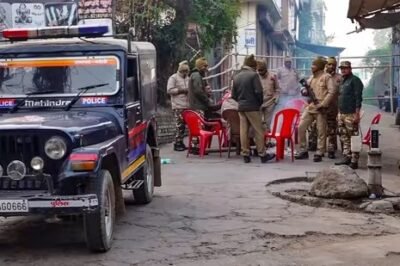The ongoing mosque dispute in Sambhal, Uttar Pradesh, has escalated into a significant issue with the Supreme Court scheduled to hear the matter today. The controversy gained national attention following a stone-pelting incident that disrupted the area’s peace. In response, UP Governor Anandiben Patel has constituted a three-member judicial inquiry commission to investigate the matter, reflecting the state’s commitment to addressing communal tensions through legal and investigative measures.
Background of the Dispute
The Sambhal mosque dispute centers on allegations of unauthorized construction and religious encroachment, leading to tensions between local communities. The situation turned volatile recently when an argument escalated into a stone-pelting incident, further polarizing sentiments in the region.
Local authorities quickly intervened to prevent further violence, imposing Section 144 to restrict large gatherings and maintain law and order. Despite these efforts, the issue has sparked widespread debate about religious harmony and property disputes in Uttar Pradesh.
Supreme Court’s Involvement
The Supreme Court’s hearing today is expected to address several critical aspects of the dispute, including:
- Legal Ownership: Determining whether the mosque construction adheres to existing laws and regulations.
- Law and Order: Assessing the adequacy of local administration’s response to the incident.
- Preventing Escalation: Issuing guidelines to avoid further communal tensions.
- The court’s judgment could set a precedent for similar disputes across the country.
Judicial Commission Formation
Governor Anandiben Patel has established a three-member judicial inquiry commission to probe the stone-pelting incident thoroughly. The commission’s mandate includes:
Investigating the root causes of the violence.
Identifying individuals or groups responsible for instigating tensions.
Recommending measures to prevent such incidents in the future.
The findings of this commission are expected to play a pivotal role in resolving the dispute and ensuring accountability.
Impact on Local Communities
The dispute has heightened communal tensions in Sambhal, with residents calling for a peaceful resolution to the matter. Key concerns include:
- Disruption of Daily Life: Businesses and schools in the area have been affected due to restrictions and heightened security.
- Fear Among Residents: The possibility of further violence has left many locals anxious about their safety.
- Impact on Religious Harmony: The incident has strained inter-community relationships, underscoring the need for dialogue and mutual understanding.
- Political and Social Reactions
The incident has drawn reactions from across the political spectrum:
- State Government: Emphasizing the need for law and order, the state government has assured impartial investigations and swift action.
- Opposition Parties: Criticized the government for failing to prevent the incident and called for greater focus on communal harmony.
- Civil Society: Advocates and social organizations have urged for dialogue to address the root causes of such disputes and foster peace.
- Need for Long-Term Solutions
- The Sambhal mosque dispute highlights broader issues of communal sensitivity and property rights.
To prevent such incidents in the future, experts suggest:
Mediation Mechanisms: Establishing neutral bodies to mediate religious or property disputes before they escalate.
Legal Clarity: Streamlining laws related to land ownership and construction near religious sites.
Community Engagement: Promoting interfaith dialogue to strengthen communal harmony.
Conclusion
The Sambhal mosque dispute is a critical test of India’s ability to balance religious sensitivities with the rule of law. As the Supreme Court hears the case and the judicial commission begins its probe, the nation watches closely for a resolution that promotes peace, justice, and accountability. Addressing the root causes of such conflicts through legal and social means is essential to preserving harmony and trust among communities.








Leave a Reply